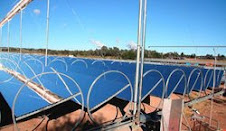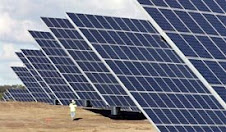article from:
SustainableIndustries.com
Industry experts analyze the sea of solar investments
Solar tip sheetby Amy Westervelt - 11.2.07
--------------------------------------------------------------------------------
As the first cleantech sector to mature, the solar industry is entering a new phase filled with public stock offerings, mergers and acquisitions, and profitable businesses. However, analysts and industry players warn that solar still has some growing to do in order to bring prices in line with traditional energy resources (or “reach grid parity” in industry-speak) without the help of subsidies.
The solar industry has successfully commercialized residential, commercial and even utility scale products, making it attractive to venture investors looking for a safe bet as they arrive on the scene of the cleantech investment race.
For those eager to invest in solar in 2008, Sustainable Industries spoke with industry experts and analysts about what to watch for as solar hits its zenith.
Market trends
According to Tim Woodward, managing director of San Francisco-based Nth Power — one of the first venture firms to invest in solar more than 10 years ago — the public market for solar is now close to saturated. Solar companies began going public in a big way in 2005, most notably with the storied initial public offering (IPO) of SunPower (Nasdaq: SPWR), during which the company’s stock jumped 41 percent on the first day, prompting comparisons to dot-com IPOs. Solar companies have continued to go public with far less fanfare in the years and months since.
Solar companies looking to go public now need to be offering a unique product or service in order to differentiate themselves enough to pique investor interest, says Woodward. That wisdom goes for American venture-backed startups, as well as the large number of Chinese solar manufacturers gaining traction in the market. Meanwhile, the consolidation of the solar market, which analysts have been predicting for the last two years, finally began with SunPower’s acquisition of PowerLight in January 2007. The trend is likely to continue, with more solar mergers and acquisitions rumored for late 2007 and beyond.
Many mergers in 2006 were driven by a silicon shortage, as larger companies bought up small or struggling companies in order to secure access to more silicon. Now, consolidation is characterized by larger energy companies buying into the solar market, or by companies that are strong in one area of the value chain buying into another, as manufacturer SunPower did when it acquired installation and service provider PowerLight. Which is not to say the silicon shortage or its effects are over, despite reports to the contrary. “The biggest short-term problem for the solar industry remains silicon supply and pricing,” Woodward says, adding that, as more supply comes online, it is being consumed by the increasing demand for solar, which has resulted in costs not coming down as quickly as people thought they might.
Continental drift
The $75 million, 11-megawatt solar system in Serpa, Portugal, designed by SunPower, tracks the sun's movement across the sky. Courtesy SunPower Corp.
To the surprise of some West Coast residents, the majority of solar demand continues to be driven by the European market, where subsidy programs are lucrative and straightforward. In the United States — even in California, which has what Woodward calls a “fantastic” incentive program — customers and solar providers have to deal with large amounts of paperwork and headaches to cash in on credits.
In Europe the process has been streamlined, making solar far easier and more popular. Tom McCalmont, CEO of REgrid Power and president of Solar Tech, a Silicon Valley-based consortium of solar companies, says customers in California fill out 40-odd pages of forms and wait several months to redeem their credits for installing solar power — a stark contrast to Germany, where the form is a single page that is processed almost immediately. The European market is also attractive to American manufacturers, which can sell panels and installation services for euros, and favorably exchange the currency for U.S. dollars.
In the not-so-distant past, the combination of a favorable exchange rate and a booming market made Europe so attractive to solar exporters that the U.S. market was suffering from a supply shortage, according to Woodward. “Panels can be shipped to Europe easily, so you’ll ship to Europe until you fulfill that demand because you get a premium over there,” he says, adding that more suppliers and favorable policies in states such as California and New Jersey have helped ease the supply problem.
Nerds of a feather
The incentive programs in California, Washington, New Jersey and other states have been at least partially helped along by a variety of industry associations that have sprouted up as the solar industry matures. In Washington, D.C., the Solar Energy Industries Association (SEIA) lobbies for national policies that are favorable to the solar industry; the Solar Alliance was recently formed in Boulder, Colo.; and in 2006 Silicon Valley-based companies, including SunPower (Nasdaq: SPWR), REgrid, Pacific Gas & Electric (NYSE: PGE), Miasolé and SolFocus, joined together to form Solar Tech and work toward establishing the Silicon Valley as the center of the U.S. solar industry.
All three groups work essentially toward the same goals: straightforward incentive programs, national net metering (it’s currently only legal for customers to sell excess power back to the local utility in 38 states) and federal interconnection legislation (connecting a solar installation to the grid can currently take up to several weeks). Solar Tech is also working on setting up training programs and installation standards to drive down the costs associated with installation, which industry experts agree is one of the primary areas where solar costs can and should be reduced.
Solar Tech founder McCalmont says his group and others in the industry are also lobbying Congress to eliminate a $2,000 cap on tax incentives for residential solar projects and to provide federal incentives to companies that manufacture solar panels in the United States. “The manufacturing process for solar is automated, so you don’t have to go with a Chinese manufacturing plant to save on labor costs,” McCalmont points out. “Companies manufacture elsewhere because other companies offer them incentives that the U.S. government does not provide.”
As has been the case with several policies in the current administration, a number of state legislatures, predominantly in the West (with the exception of New Jersey) have taken incentive issues into their own hands.
While federal incentives that can be universally applied and easily accessed by both individuals and businesses are the ultimate goal, state programs are helping to fill the void until such policies are put in place. California’s SB1 established a 10-year, $3.3 billion incentive program that, combined with the state’s renewable portfolio standard (RPS), sends a clear signal to investors that the solar market in California is here to stay. The policy helped to increase both venture capital investments in California solar startups and corporate and individual investments in solar systems.
Utility scale solar projects are a key piece of the industry's growth, fueling investments in system and component manufacturers.
Oregon’s Business Energy Tax Credit (BETC) and recently passed RPS have spurred solarindustry growth in the state and helped it to attract what is slated to be America’s largest solarmanufacturing plant, Germany-based SolarWorld’s planned 500-megawatt facility, to Hillsboro. SolarWorld executives cited BETC and Oregon’s skilled labor pool as primary incentives for locating its plant in the state [see “SolarWorld plant brightens Oregon,” SI, April 2007].
The state of Washington passed two solar incentive laws in 2005. Senate Bills 5101 and 5111 provide, respectively, a base credit of 15 cents per kilowatt-hour of electricity generated from photovoltaic (PV) systems to residences and business, and a 40 percent reduction of the state’s business and occupation tax for manufacturers and wholesale marketers of solar PV modules or silicon components of those systems [see “Washington: the new Sunshine State?”, SI, February 2006].
Unlike incentive programs in California, New Jersey and Oregon, which pay based on system size, Washington’s utilities pay solar-energy-producing individuals and companies for the actual output from their systems. If a system under-performs or breaks down, the owner doesn’t get paid. The hope is that the law will promote careful installation have worked to retain existing Washington-based manufacturers and even to encourage some expansion: Moses Lake-based Renewable Energy Corporation broke ground on a new polysilicon plant in 2006, and Vancouver, B.C.-based Xantrex Technologies is considering expanding its Arlington, Wash., inverter plant. But to date, they have yet to attract new manufacturers to the state. In addition to state incentive programs, the Western Governors Association officially made increasing renewable energy production a goal for western states in 2006.
In 2007, the governors of Arizona, California, New Mexico, Oregon, Utah and Washington set up a regional system to reduce greenhouse gas emissions 15 percent below 2005 levels by 2020. Should state programs and Solar Tech’s efforts succeed in creating national incentives, there could be an increase in solar-manufacturing companies stateside.
But they will continue to encounter stiff competition, particularly from China, where solar manufacturing companies have succeeded in penetrating the global solar market over the past two years. “No one is pointing to Chinese manufacturing companies as cutting-edge innovators, but they are providing low-cost manufacturing,” Woodward says.
Solar Power Investing Site
Best Green Stocks Investing Blog
Subscribe to:
Post Comments (Atom)
Yuya Joe Blog
Lake Ontario Waterkeeper
The Daily Beast -Politics Blog
21stArch.com - 21st Century Architecture
Original Joe College Blog
WikiLeaks Foreign Policy Analysis
AGreenRealtor.com Real Estate Blog - Ecology Energy Efficiency
Best Green Stocks Investing Blog
PV Intell Photovoltaic Solar Stocks Investing
SEARCH Leading Alternative Energy and Ethical Investing websites

Custom Search
Daily Kos
Rare Earth Stocks Research
Patrick MacManus's Blog Peace and Collaborative Development
BeesTreesFrogsElephants.com - Nature and Ecology Blog
Research Green Energy stocks, Clean Energy investing information
Find wind power investing info online, clean energy mutual funds, geothermal stocks, solar energy investments.

Green Energy Investing Network:
Green Stocks Investing Clean Power Blog
SolarIntell.com Renewable Power Investing Website
Wind Intell.com Wind Energy Stocks Company Links
Geothermal Power Investing Public Companies
PV Intell.com Leading Photovoltaic Solar Energy Stocks

Custom Search
Green Energy Investing Network:
Green Stocks Investing Clean Power Blog
SolarIntell.com Renewable Power Investing Website
Wind Intell.com Wind Energy Stocks Company Links
Geothermal Power Investing Public Companies
PV Intell.com Leading Photovoltaic Solar Energy Stocks







No comments:
Post a Comment